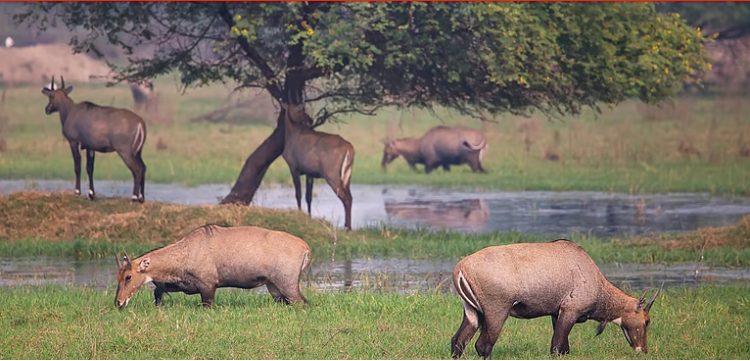In a first, 913 blackbuck and Nilgai herded from the air into ‘bomas’ in MP’s Shajapaur

IN NEWS
In a first-of-its-kind operation, the Madhya Pradesh Forest Department successfully herded 913 blackbuck and Nilgai from revenue lands in Shajapur district using a helicopter-based technique. The initiative, assisted by experts from South Africa’s Conservation Solution, aimed at mitigating human-wildlife conflict caused by herbivores damaging crops in agricultural areas.
ANALYSIS
- Objective of the Operation:
- To address the recurring issue of crop losses faced by farmers due to blackbuck and Nilgai entering agricultural fields from non-forest areas.
- To translocate these animals safely into designated protected habitats.
- Scale and Uniqueness:
- The operation involved 913 animals and was conducted over 11 days.
- It marks the first successful aerial herding and capture operation for wild herbivores in India.
- The animals were captured without human contact, using grass and green-netted enclosures called ‘bomas’.
- Execution and Logistics:
- A team of 150 officials, veterinarians, and experts worked under Divisional Forest Officer Beerendra Kumar Patel.
- Helicopters were deployed to guide animals into bomas for safe capture.
- The initiative was carried out in coordination with the revenue department to ensure safety for both humans and wildlife.
- Destination of Translocated Animals:
- The herded blackbuck and Nilgai were relocated to:
- Rani Durgavati Tiger Reserve
- Nauradehi Wildlife Sanctuary
- Gandhisagar Wildlife Sanctuary
- Kuno National Park
- The herded blackbuck and Nilgai were relocated to:
- Role of International Expertise:
- The operation was executed with the assistance of Conservation Solution, a South Africa-based company specializing in large herbivore translocation (including elephants and rhinos).
- The method adopted was non-invasive, and Indian forest officials were trained in these techniques for future replications.
- Challenges Faced:
- Required inter-departmental approvals and coordination across districts.
- Ensuring minimal stress and no harm to animals and humans during the operation.
- Managing herding activities in areas with dense human populations.
- Outcome and Significance:
- The operation is being hailed as a model for mitigating human-wildlife conflict in agricultural zones.
- It sets a precedent for ethical wildlife management and capacity-building among Indian forest officers.
- Farmers have welcomed the initiative as a long-term solution to crop protection.
STATIC PART
- Blackbuck (Antilope cervicapra):
- Listed under Schedule I of the Wildlife Protection Act, 1972 (providing highest legal protection).
- Classified as Least Concern (IUCN Red List) but faces habitat loss and human conflict.
- Nilgai (Boselaphus tragocamelus):
- India’s largest Asian antelope, also protected under Schedule III of the Wildlife Protection Act, 1972.
- Commonly found across north and central India; known for causing agricultural damage in farmlands.
- Boma:
- A temporary enclosure made of natural materials (grass, nets, fencing) used for capturing or holding wild animals safely during translocation.
- Human-Wildlife Conflict:
- Refers to interactions between humans and wild species that result in negative outcomes, such as crop damage, livestock loss, or injuries.
- Effective mitigation strategies include translocation, habitat restoration, and community awareness.
Updated – 09 Nov 2025, 11:53 AM | Down To Earth